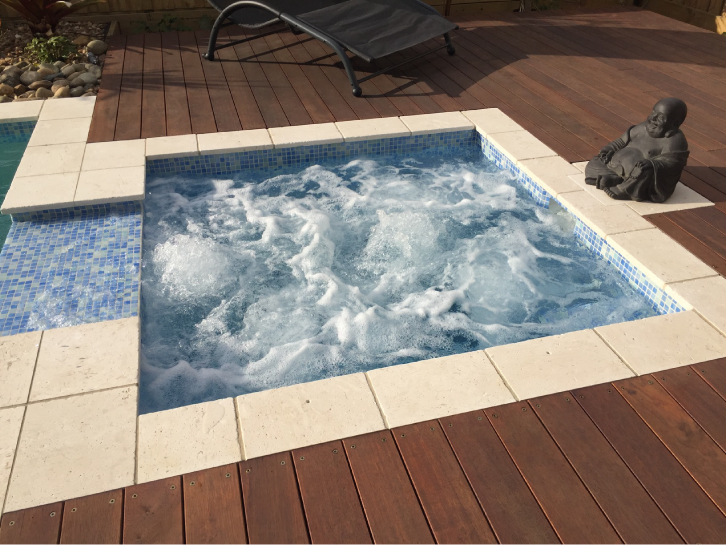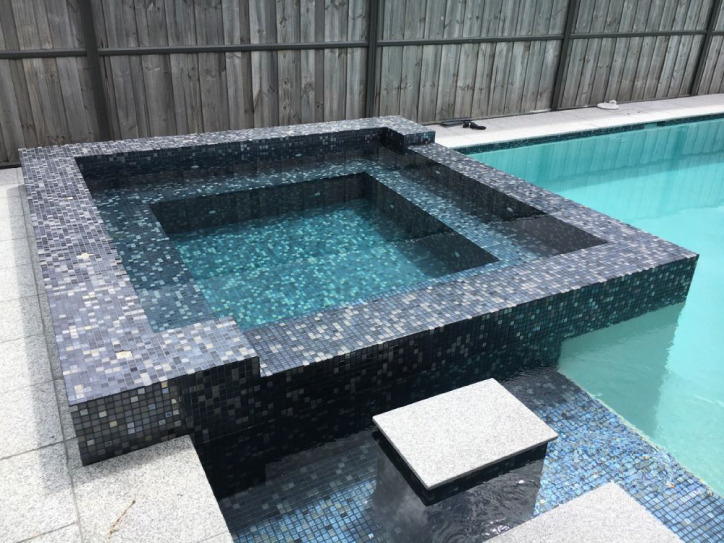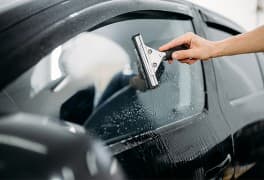
Find a local pool and spa builder
- Inspiration /
- Outdoor projects /
- Outdoor living /
- Spa owners guide:...
Spa owners guide: Types, cleaning & maintenance
Helping you get into hot water - the good kind
A spa – also known as a hot tub or a jacuzzi – is essentially bathtub that recirculates water through pressurised jets and an optional in-line heater. This offers a direct massage when you’re sitting in front of a water jet. The water pressure can be directed to massaging sore muscles in your back and neck. Additionally, you get an all over massage from the swirling water. If you’re thinking of buying a spa, or are looking for the best way to clean and maintain one, read our guide to avoid getting yourself into hot water.
Types of hot tubs
Much like pools, there are two types of spas: in ground, and above ground. In-ground spas can be placed either at surface level or on a specially constructed deck. On the other hand, above-ground spas are like bathtubs and are placed above ground. Both come in a variety of shapes and sizes. Some can seat up to six, while others are 4-metre long swimming spas.
The most common types of spas are:
- Portable Spa – Relatively inexpensive and, as the name suggests, these spas are portable.
- Swim Spa – These spas are designed for swimming in place, similar to the way you would run on a treadmill. They tend to be longer and narrower with high-pressure jests at one end of the pool.
- Therapeutic Spa – These are designed for hydrotherapy.
- Spa Baths – The smaller design of these spas makes them great for indoor use by a single user.
In-ground spas
In-ground spas, as the name suggests, is installed into the ground usually next to an in-ground pool. This style is more customisable, and can fit more easily into your space’s aesthetic.

Portable & semi-portable spas
Another option to consider, particularly if you don’t have a pool is an above-ground portable or semi-portable hot tub. Semi-portable hot tubs aren’t exactly portable – they usually weigh between 180 and 450 kilograms, but they are easier to move and to install. The largest regular hot tubs can take a crane to install, so a semi-portable definitely has advantages.
Actual portable hot tubs are inflatable and can weigh as little as 42 kilograms and fold up pretty compactly. And they can be pretty well featured; a higher-end model may have 136 bubble jets, heat up to 42 degrees Celsius, and seat up to six people. Some even have built-in filtration systems! Inflatable hot tubs cost around $1000.
Spa maintenance
An ordinary bathtub needs to be drained after every use, but a spa has a filtration system and chemicals to keep it clean. However, you will need to periodically drain the spa for cleaning and maintenance. These procedures vary slightly between brands and models, so it’s a good idea to ask about the particular maintenance requirements before purchasing a new spa.
Keep the water chemically balanced
Micro-organisms grow quickly in warm water, so it’s crucial to check the water every day and use additives when necessary. Check the pH level. It should read 7.4 ppm (or parts per million), allowing for a variation of minus or plus .2 ppm. A too-low pH level can corrode the filter and the pipes while a too-high level can cause algae and bacteria to grow.
Add chemicals as and when required to maintain the desired pH and alkaline levels. Most spa owners use chlorine or bromine in their water. Another beneficial technique that can help keep your spa water from turning cloudy and unattractive is to shock the spa water frequently. • Water clarifiers are a valuable additive because they solidify oils, which can then be removed through the filtration system.
Check the filter
A clean filter is essential to prevent debris building up and the water from turning cloudy. The spa’s filtration system needs to be kept in good shape, with proper use and regular maintenance. Check your filter at least once a week, cleaning it whenever necessary – usually monthly – and replacing it once a year. If you use the spa very frequently, you may have to clean or replace the filter more often.
At least every two weeks, pressure clean the filter with a garden hose or power washer set at a low or medium level; don’t use high pressure, as it may cause damage. When the filter is dry, brush it to remove loose particles of debris. Keep your filtration system running for three or four hours daily, whether you’re using the spa or not.

Avoid oil & soap
If you use the spa wisely and carefully, you can keep it clean for longer. Do not enter the water with oil, soap, sunscreen, deodorants or other products on your body or hair, since these make the water cloudy and dirty. In this case, you will need to overwork the spa filter to get rid of these impurities. It is a good idea to tie up your hair or use a plastic cap while in the spa. Avoid using soap or an ammonia-based agent to clean the spa, since these products can affect the chemical balance of the water in your spa. A much better alternative is to use special spa cleaning solutions or a mixture of bleach and water.
Using an Ozone Generator
An ozone generator is a worthy investment for your spa. It breaks down the oils and other organic matter that contaminate the spa water, thus making it clean and hygienic. As the ozone generator runs, it boosts the functioning of your spa filter and the other chemicals used to clean the spa.
Since different portable spa models require different types of maintenance, it’s a good idea to talk to a portable spa dealer to find out about maintenance dos and don’ts. By keeping your spa and filtration system clean, you’ll be able to enjoy all the relaxing health benefits of your spa without having to worry about possible risks lurking in those soothing warm waters.
Contact local pool and spa experts
Why are micro-organisms a problem?
Micro-organisms are even more of a risk in spas than in swimming pools because of the warm temperatures involved. The recommended temperature for a portable spa is 36 to 38 degrees Celsius, which is also the perfect temperature for micro-organisms to grow and spread. In addition, a spa contains less water than a swimming pool, which can mean a significantly greater concentration of these troublemakers if they’re left unchecked.
Micro-organisms can cause infections of the ear, eye, nose and throat. They can also cause gastric ailments and severe respiratory disease. That’s why spa makers always include filters and accessories to help you keep your spa water clean and bacteria-free.
Related posts
How much will your job cost?
The Oneflare Cost Guide Centre is your one-stop shop to help you set your budget; from smaller tasks to larger projects.



